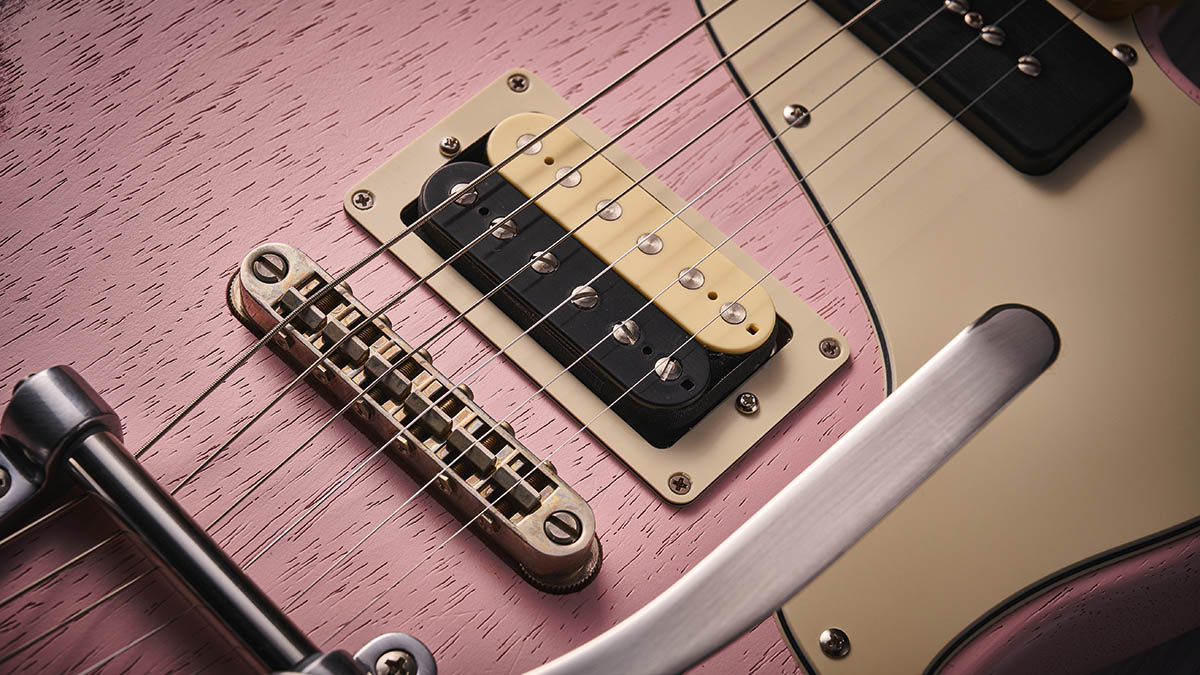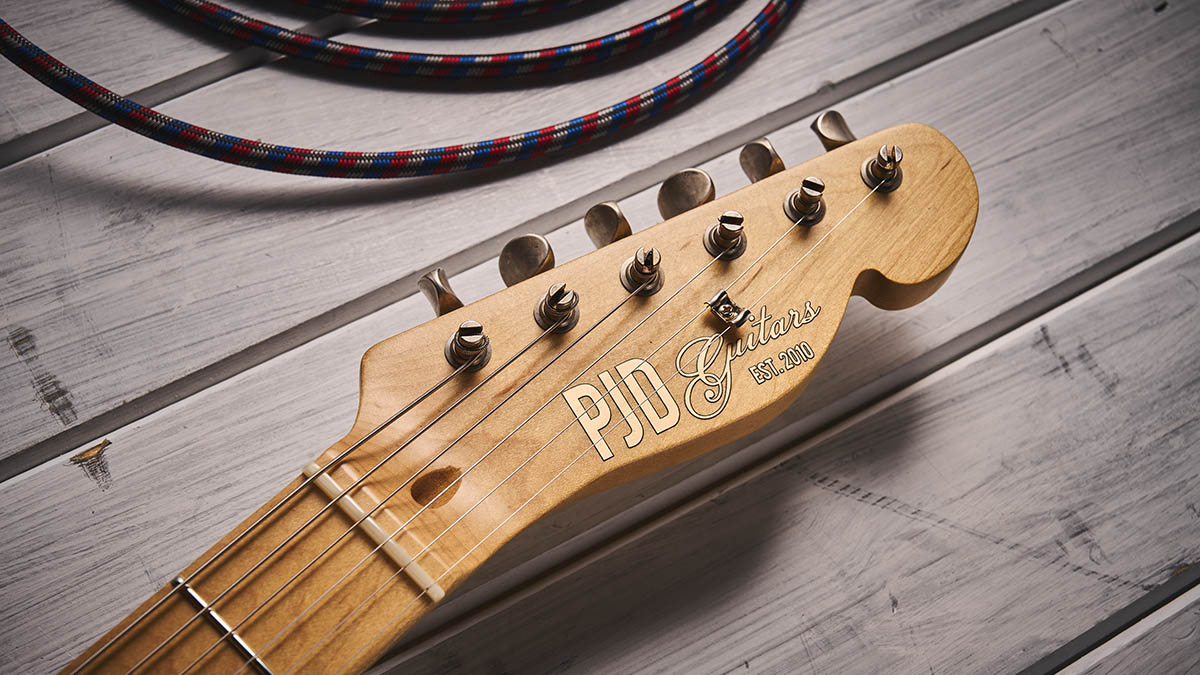Guitar World Verdict
It’s the feel and playability and the new, more mainstream neck shape that punch well above the price point here. Superb craft in non-precious dress and an obvious choice for any gigging musician.
Pros
- +
Crisp build and excellent weight.
- +
Proper bolt-on neck join. New neck shape.
- +
Big rock‑aimed voices.
- +
Large colour choice.
- +
Nicely integrated Bigbsy vibrato.
Cons
- -
A more classic pickup set option would broaden the sonic appeal – watch this space.
You can trust Guitar World
Production-style methodology has always been at the heart of PJD: clean craft and design, well executed and far from expensive. In fact, its new Standard range – which kicked off in 2023 and includes the single-cut Carey, the S-style Woodford, the original-shaped T-inspired York and PJD’s previously best-selling offset guitar St John – actually kicks off at just £1,299.
The next Standard Plus tier all include vibratos at £1,499, while a lightly worn-looking ‘spray over’ finish, available on both levels, adds between £250 and £300.
The York-based brand has also recently installed a Plek machine to add further consistency as the company slowly ramps up production. It’s a long way from the ‘man-in-shed’ style of many Brit makers. But while the build is purposely streamlined, the craft remains very tidy.
The main difference between the new 2023-onwards Standards and the earlier, more expensive models of the same name is the switch from chambered lightweight ash bodies to solid (but still lightweight) obeche.
While the inspiration is obvious with our offset – it’s slightly downsized from the Jazzmaster template – we get an arm-rest-style forearm contour and a lightly dished ribcage cutaway on the back.
The edges are radiused like a Strat or Jazzmaster, unlike the sharper chamfered edges of the original Standards, while the finish is very thin nitro that’s silky smooth and open pore.
There are quite a few finish options, too, including the Shell Pink over sunburst of our review model – hardly a true relic, but it all ties in with the lightly aged hardware to create a far from precious lived-in and well-gigged feel.
All the latest guitar news, interviews, lessons, reviews, deals and more, direct to your inbox!

Another change from the earlier Standards is that the often figured, quarter-sawn roasted maple stock used for their necks switches to industry-standard slab-sawn unroasted maple, again with a super-smooth light satin finish.
We also have a more regular transfer headstock logo; the earlier models’ logos were cut with a laser. The relatively small body heel is very rounded and the neck is held to the body with recessed bolts, not screws.
More changes come with the pickups, which are now made in-house (rather than aftermarket, typically Bare Knuckle Boot Camp or Cream T) with whimsical names: a zebra-coil Wadfather at the bridge and a Parkins Cream soapbar single coil in the neck position. Controls are simple and there’s nothing to get in the way of rocking this one.

Feel & Sounds
The fretwork and setup on those earlier Standard models was always exemplary and nothing changes here. We now have a standard 254mm (10-inch) fingerboard radius, as opposed to the earlier lightly compound radius, although the medium jumbo Jescar frets remain the same and they are perfectly installed and mirror-polished, plus there’s some light fingerboard edge rolling.
The neck shapes have subtly changed, however. Our earlier Standard model measures 22.1mm in depth at the 1st fret and 23mm by the 12th, whereas our new Standard Plus checks in at 20.5mm at the 1st and 21.8mm by the 12th.
It’s a noticeably thinner-feeling neck, but, if anything, the new shaping feels better in the hand because it’s fractionally narrower and is a near-perfect C with lovely sloping shoulders. The fretwork – not to mention the perfect Plek setup – also feels somehow smoother.

Just checking over the guitar unplugged, there’s nothing ‘cost effective’ at all about the feel. It’s hugely engaging and on playability alone we’re feeling like we’re playing a much more expensive guitar. It even feels more expensive than our own well-gigged original Standard in that department, and we’ve always thought that was pretty good.
While the new York Standard we reviewed last year was, by intent, a lively and good-sounding T-style, this St John comes across as the snotty-nosed yob of the family. The Wadfather sends our clean channel into light break-up, and our usually ‘on the edge of break-up’ crunch channel is nodding towards juicy saturation. It’s a hot-sounding pickup that pulls down the resonant frequency and rounds the highs with a full-fat midrange thickness.
The neck pickup might be based on a pickup that was conceived in the mid‑1940s, but it holds its own here with push, edge and vocal depth, and while the mix certainly isn’t a classic offset voice it adds some welcome bounce and nicely rounded jangle – very Peter Buck, in fact.

It doesn’t sound like we have a treble bleed on the volume, so pulling that down obviously cleans things up a little, but you do lose a little definition. There’s no coil-split for the bridge, either, which would probably work well to add a little Fender-y attack on its own or voiced with the neck.
So, while it might not be the most stylistically versatile PJD we’ve ever plugged in, don’t be fooled by the light pink finish – this St John has certainly got attitude in truck loads.
The Bigsby is no wide-travel whammy, but the light shimmers here add some welcome retro flavour to the St John. That recessed tune-o-matic has smooth saddle grooves and slightly rocks as you move the arm, and the light travel means that tuning stability is very good, too. No complaints here.

Verdict
The new PJD Standards are very aggressively priced for a UK build, and although the combination of the Plus-level vibrato and the ‘spray over’ finish increases the cost here, the quality and feel of the build remains superb.
Yes, we’d love to see a more classic pickup set option, not least for those of us who use pedals to increase power and thickness. But as it is, the St John excels at powerful indie/alt-rock and more. It’s a really strong-sounding voice, though both the neck and mix can sound very sweet with a little volume reduction, too.
Moreover, it’s the feel and playability and the new, more mainstream neck shape that punch well above the price point here. Superb craft in non-precious dress and an obvious choice for any gigging musician.
Specs
- PRICE: £1,749 (inc gigbag)
- ORIGIN: UK
- TYPE: Offset-shaped solidbody electric
- BODY: Obeche
- neck: Maple, bolt-on
- SCALE LENGTH: 648mm (25.5”)
- NUT/WIDTH: Bone/42.23mm
- FINGERBOARD: Maple, rectangular black acrylic inlays, 254mm (10”) radius
- FRETS: 22, medium (Jescar 55090)
- HARDWARE: Recessed tune-o-matic bridge, licensed Bigsby B50 vibrato, Gotoh vintage-style SD91 split-post tuners – light aged nickel-plated
- STRING SPACING, BRIDGE: 51.5mm
- ELECTRICS: PJD Wadfather zebra-coiled humbucker (bridge), Parkins Cream single coil soapbar (neck), 3-way toggle pickup selector switch, master volume and tone
- WEIGHT (kg/lb): 2.93/6.45
- OPTIONS: Colour choice with ‘spray over’ option (adds £250-£300). More options during 2024
- RANGE OPTIONS: Carey, York, St John and Woodford models start in the new Standard spec at £1,299. All come with Bigsby vibratos as the Standard Plus (except the Woodford, which uses a synchronised vibrato) and are priced at £1,499. PJD also now offers a custom service (£POA)
- LEFT-HANDERS: Yes, no extra charge
- FINISHES: Shell Pink ‘spray over’ (as reviewed), Cream Soda, Midnight Black, Sonic Blue, Ocean Jade Metallic, Aubergine, TV Yellow, Firemist Gold, Pelham Blue, 3 Tone Sunburst – low-gloss open‑pore nitro body; satin nitro neck/’board
- CONTACT: PJD Guitars

Dave Burrluck is one of the world’s most experienced guitar journalists, who started writing back in the '80s for International Musician and Recording World, co-founded The Guitar Magazine and has been the Gear Reviews Editor of Guitarist magazine for the past two decades. Along the way, Dave has been the sole author of The PRS Guitar Book and The Player's Guide to Guitar Maintenance as well as contributing to numerous other books on the electric guitar. Dave is an active gigging and recording musician and still finds time to make, repair and mod guitars, not least for Guitarist’s The Mod Squad.

